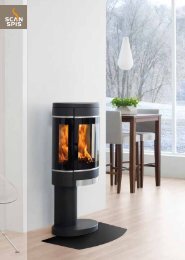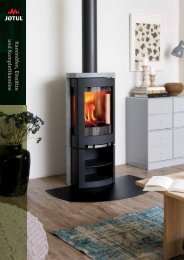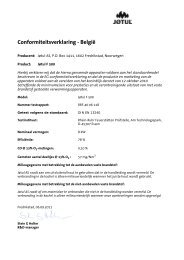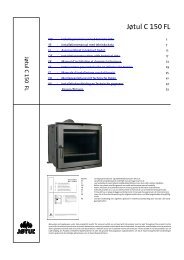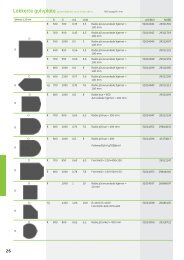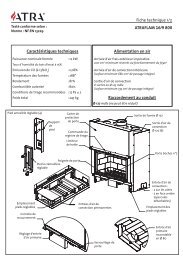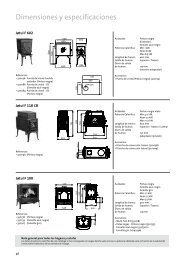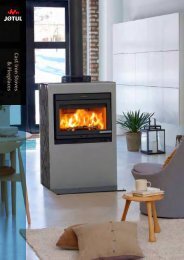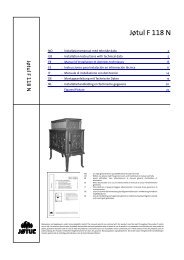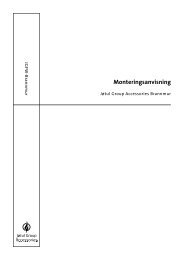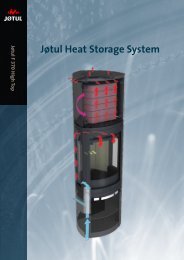Chapter 7, part 1 - Jøtul stoves and fireplaces
Chapter 7, part 1 - Jøtul stoves and fireplaces
Chapter 7, part 1 - Jøtul stoves and fireplaces
You also want an ePaper? Increase the reach of your titles
YUMPU automatically turns print PDFs into web optimized ePapers that Google loves.
The market for <strong>stoves</strong> <strong>and</strong> <strong>fireplaces</strong> using solid fuel, on the other h<strong>and</strong>, was in stagnation <strong>and</strong> <strong>part</strong>ial<br />
decline.<br />
Europe seemed to present a similar interest in gas, even though here wood-fired units still domiated.<br />
The American market for gas products was already large, <strong>and</strong> that alone could presumably justify an<br />
increased focus on this sector, was the thought at Jøtul. And since the interest in gas was increasing<br />
in Europe as well, a focus on gas products could also be beneficial in other markets. 387<br />
Certain efforts in this area had already been attempted. In 1992 Jøtul had begun a co-operation with<br />
the British company Stovax to produce gas <strong>stoves</strong> <strong>and</strong> <strong>fireplaces</strong>. The first practical result of this cooperation<br />
was a gas fireplace called Jøtul 3 Gas. The model was introduced in the United States in<br />
1995–96, <strong>and</strong> it was extremely well received. Jøtul therefore continued its co-operation with Stovax<br />
<strong>and</strong> at the same time began to negotiate with American companies to initiate co-operation in this<br />
area. Eventually this led to an agreement with the Superior Company for the development <strong>and</strong><br />
manufacture of gas-fired <strong>stoves</strong> <strong>and</strong> <strong>fireplaces</strong> for the American <strong>and</strong> European markets.<br />
The development <strong>and</strong> production of the new gas models was done at first at Stovax <strong>and</strong> Superior.<br />
But for Jøtul the co-operation brought with it access to valuable expertise <strong>and</strong> technology in the gas<br />
area which eventually made it possible for the company to develop gas products on its own. 388 In<br />
1996 two positions were set up at the development de<strong>part</strong>ment in Fredrikstad which would be<br />
devoted exclusively to developing gas products. The same year a co-operation was also established<br />
with Jøtul’s importer in the Benelux countries – Helex – to sell gas-based <strong>stoves</strong> <strong>and</strong> <strong>fireplaces</strong> on the<br />
European markets.<br />
In 1998 the American Bret<br />
Watson was hired as President<br />
at Jøtul Inc. in Portl<strong>and</strong>, Maine.<br />
Watson had a great deal of<br />
experience in the American<br />
stove industry, including his<br />
tenure as marketing director<br />
of Hearthstone.<br />
In the ensuing years Jøtul experienced a fairy-tale development on the American market. As early as<br />
1996 there was significant growth in turnover. From 1996 to 1997 turnover in the United States rose<br />
by 50 per cent, from 40 million kroner to 60 million kroner. The growth was primarily due to<br />
increased sales of gas products. The expansion in this area continued the next year, when turnover<br />
rose to almost 83 million kroner. And in 1999 sales virtually exploded. In that year Jøtul had turnover<br />
of about 169 million kroner in the United States, which corresponded to an increase of 104 per cent<br />
compared with the preceding year. This meant that the American market had become bigger than<br />
the Norwegian one, which that same year had a turnover of 139 million kroner. For the first time in<br />
Jøtul’s history, a single export market was bigger than the domestic market.<br />
There were basic differences between Jøtul’s first great expansion period in the United States in the<br />
latter <strong>part</strong> of the 1970s <strong>and</strong> the expansion that occurred in the latter <strong>part</strong> of the 1990s. While the<br />
expansion in the 1970s was almost exclusively dem<strong>and</strong>-driven, the one twenty years later was to a<br />
great extent the result of an active marketing strategy on Jøtul’s <strong>part</strong>.<br />
The expansion in the 1990s was largely the result of a comprehensive market adaptation built on<br />
two basic premises. First, as we have seen, the focus on the gas sector was derived directly from the<br />
desire to win market share in the United States. Second, Jøtul concentrated on adapting new products<br />
to American taste preferences. Such an adaptation to national needs was nothing new, of<br />
Reconstruction <strong>and</strong> New Expansion 219



